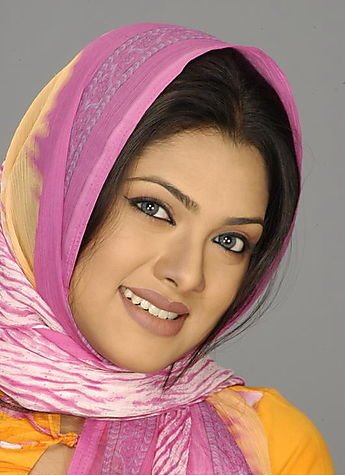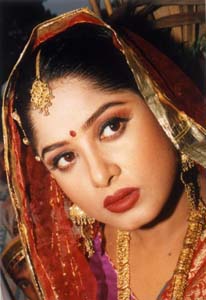Source (Google.com.pk)
Bangladeshi TV Actress Biography
The Bangladeshi film industry has been based in Bangladesh's capital, Dhaka, since 1956. As of 2004, it produced approximately 50 movies a year, with an average movie budget of about 20,000,000 Bangladeshi taka. The film industry is sometimes known as Dhallywood, a portmanteau of the words Dhaka and Hollywood.History
BFDC Main Gate 2011
On April 24, 1898, the Bengali weekly Dhaka Prakash reported that films were shown in Dhaka by the Bradford Bioscope Company, at the Crown Theatre, in Patuatuli, near Sadarghat. The show included news items and other short features. The first permanent cinema in Dhaka, named Picture House, began operation during 1913–1914. This cinema was renamed to New Picture House and then again to Shabistan. By 1947 there were around 80 cinemas in what is now Bangladesh.
The first Bengali organization for producing and exhibiting films was the Royal Bioscope Company, established in 1898 in Calcutta by Hiralal Sen. Although feature films were made in Bengali as early as 1919 (Bilwa Mangal), most production was done in Calcutta. The Nawab family of Dhaka produced Sukumari (1928–1929) and The Last Kiss (1931).
After the partition of India in 1947, the first film made in East Pakistan was a newsreel about the visit of Mohammad Ali Jinnah, produced in 1948 by the radio broadcaster Nazir Ahmed. The first full-length feature film with sound made in East Pakistan was Mukh O Mukhosh, which was produced by Abdul Jabbar Khan and released on August 3, 1956. Editing, printing and all other film processing for this movie was done in Lahore, Pakistan.
The East Bengal Provincial Assembly established the East Pakistan Film Development Corporation (EPFDC) on April 3, 1957. The first film produced by this organization was Asiya (The Life of a Village Girl, 1960), directed by Fateh Lohani. During the late 1960s, between 20 and 35 films were produced each year. Production quantity continued to increase after Bangladesh gained its independence on December 16, 1971; in 1979, for example, 51 films were released, and in the 1990s over 90 films per year were released. One of the first films produced in Bangladesh after independence was Titash Ekti Nadir Naam (A River Called Titas) in 1973 by acclaimed director Ritwik Ghatak, whose stature in Bengali cinema is comparable to that of Satyajit Ray and Mrinal Sen.
Poet Kazi Nazrul Islam's statue in BFDC.
Although the majority of the films made in Bangladesh are strictly commercial in nature, a handful of directors from Bangladesh have attained critical acclamation for their outstanding work. Zahir Raihan, Khan Ataur Rahman, Salahuddin, Alamgir Kabir, Amjad Hussain, Moshiuddin Shaker, Sheikh Niyamat Ali,Mostofa sarwar farooki, Humayun Ahmed, Morshedul Islam, Tanvir Mokammel, Tareque Masud, Salauddin Lavlu are among those prominent directors. Bangladesh has been officially submitting nominations for the Academy Award for Best Foreign Language Film from 2003. Masud's Matir Moina (The Clay Bird) was the first film to be submitted, and won a number of other international awards from the Edinburgh, Palm Springs, Montreal, Marrakech, Cairo and Cannes Film Festivals. Another internationally acclaimed filmmaker from Bangladesh is Morshedul Islam, who won major awards at the International Filmfestival Mannheim-Heidelberg and other international film festivals.
Recently, the Bangladeshi film industry has faced increased competition from foreign films, satellite TV, home video, and other sources. Viewership of Bangladeshi films has dropped, and the industry has been criticized for producing low-quality films whose only appeal is that of sex, violence, or melodrama.












Bangladeshi TV Actress Biography
The Bangladeshi film industry has been based in Bangladesh's capital, Dhaka, since 1956. As of 2004, it produced approximately 50 movies a year, with an average movie budget of about 20,000,000 Bangladeshi taka. The film industry is sometimes known as Dhallywood, a portmanteau of the words Dhaka and Hollywood.History
BFDC Main Gate 2011
On April 24, 1898, the Bengali weekly Dhaka Prakash reported that films were shown in Dhaka by the Bradford Bioscope Company, at the Crown Theatre, in Patuatuli, near Sadarghat. The show included news items and other short features. The first permanent cinema in Dhaka, named Picture House, began operation during 1913–1914. This cinema was renamed to New Picture House and then again to Shabistan. By 1947 there were around 80 cinemas in what is now Bangladesh.
The first Bengali organization for producing and exhibiting films was the Royal Bioscope Company, established in 1898 in Calcutta by Hiralal Sen. Although feature films were made in Bengali as early as 1919 (Bilwa Mangal), most production was done in Calcutta. The Nawab family of Dhaka produced Sukumari (1928–1929) and The Last Kiss (1931).
After the partition of India in 1947, the first film made in East Pakistan was a newsreel about the visit of Mohammad Ali Jinnah, produced in 1948 by the radio broadcaster Nazir Ahmed. The first full-length feature film with sound made in East Pakistan was Mukh O Mukhosh, which was produced by Abdul Jabbar Khan and released on August 3, 1956. Editing, printing and all other film processing for this movie was done in Lahore, Pakistan.
The East Bengal Provincial Assembly established the East Pakistan Film Development Corporation (EPFDC) on April 3, 1957. The first film produced by this organization was Asiya (The Life of a Village Girl, 1960), directed by Fateh Lohani. During the late 1960s, between 20 and 35 films were produced each year. Production quantity continued to increase after Bangladesh gained its independence on December 16, 1971; in 1979, for example, 51 films were released, and in the 1990s over 90 films per year were released. One of the first films produced in Bangladesh after independence was Titash Ekti Nadir Naam (A River Called Titas) in 1973 by acclaimed director Ritwik Ghatak, whose stature in Bengali cinema is comparable to that of Satyajit Ray and Mrinal Sen.
Poet Kazi Nazrul Islam's statue in BFDC.
Although the majority of the films made in Bangladesh are strictly commercial in nature, a handful of directors from Bangladesh have attained critical acclamation for their outstanding work. Zahir Raihan, Khan Ataur Rahman, Salahuddin, Alamgir Kabir, Amjad Hussain, Moshiuddin Shaker, Sheikh Niyamat Ali,Mostofa sarwar farooki, Humayun Ahmed, Morshedul Islam, Tanvir Mokammel, Tareque Masud, Salauddin Lavlu are among those prominent directors. Bangladesh has been officially submitting nominations for the Academy Award for Best Foreign Language Film from 2003. Masud's Matir Moina (The Clay Bird) was the first film to be submitted, and won a number of other international awards from the Edinburgh, Palm Springs, Montreal, Marrakech, Cairo and Cannes Film Festivals. Another internationally acclaimed filmmaker from Bangladesh is Morshedul Islam, who won major awards at the International Filmfestival Mannheim-Heidelberg and other international film festivals.
Recently, the Bangladeshi film industry has faced increased competition from foreign films, satellite TV, home video, and other sources. Viewership of Bangladeshi films has dropped, and the industry has been criticized for producing low-quality films whose only appeal is that of sex, violence, or melodrama.
Bangladeshi TV Actress

Bangladeshi TV Actress

Bangladeshi TV Actress

Bangladeshi TV Actress

Bangladeshi TV Actress

Bangladeshi TV Actress

Bangladeshi TV Actress

Bangladeshi TV Actress

Bangladeshi TV Actress

Bangladeshi TV Actress

Bangladeshi TV Actress

Bangladeshi TV Actress

Bangladeshi TV Actress

No comments:
Post a Comment